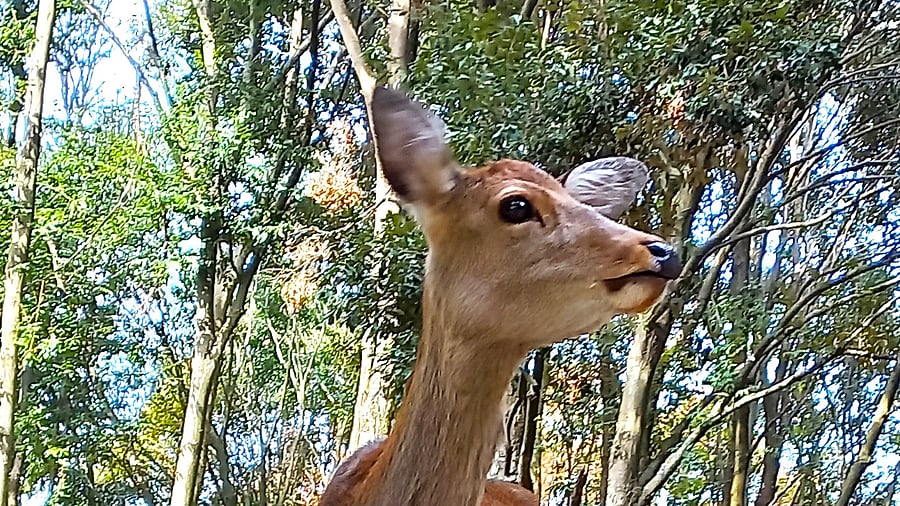
A doe in Nara, Japan.
Credit: Photo by author
The allure of Bambi, that lovable forest friend many of us grew up adoring, is undeniable! Who didn’t secretly wish to pet Bambi or have a real-life encounter with such a gentle soul? If that childhood fantasy still lingers in your heart, then Nara beckons.
Nestled in the heart of Japan, Nara unveils a sanctuary where the ethereal meets reality. A stroll through the landscape feels straight out of a fairytale, where graceful creatures — the revered Sika deer — wander freely, welcoming visitors with curiosity. I did exactly that, stepping into a realm where childhood dreams came alive. Nature intertwines with magic here. The opportunity to interact with these magnificent creatures feels almost surreal, with free-roaming deer and world-famous shrines, all wrapped in an ancient time frame. Modernity has yet to touch these grounds.
Nara Park, established in 1880, began with a 14-hectare area within the grounds of Kofuku-ji, which was government-owned land, and has expanded over the years. Today, Nara Deer Park spans 660 hectares, with part of it stretching to the grounds of Kasuga Taisha Shrine. According to local legend, Takemi Kajichi no Mikoto, the deity of Kasuga Taisha Shrine, is said to have ridden to Nara upon a sacred deer. As a result, the deer are considered messengers of the gods in Shinto beliefs. But don’t mistake them for being worshipped — these deer are wild and can fend for themselves.
Authorities have taken steps to create a safe environment for both the deer and tourists. The park features an abundance of plant life, including grass, silver pampas grass, and other varieties of land grasses, allowing the deer to thrive. While the deer can find their own food, they will humbly accept crackers if offered — and even bow in gratitude.
Several vendors have set up small makeshift counters selling “deer crackers,” or “shika senbei.” A pack of 10 crackers costs 200 yen. Made from wheat flour and rice bran without any sugar, these crackers are safe for the deer and contribute to their health. Notably, these deer crackers hold a trademark under the Foundation for the Protection of Deer in Nara, and a significant portion of the proceeds is dedicated to safeguarding and nurturing the well-being of these majestic creatures. This cycle of care and conservation strengthens the harmony within this enchanting sanctuary.
In the shared domain of humans and deer, several rituals are upheld to ensure a balanced coexistence. Among these practices is the significant tradition of antler cutting, known as “Shika no Tsunokiri,” or the Deer Antler Cutting Ceremony, which has been practised for over three and a half centuries. Held annually in October, the ceremony aims to safeguard both visitors and caretakers as well as the deer themselves from potential harm.
This solemn ritual resonates with the ethos of mutual respect between the inhabitants of this shared space. By carefully trimming the antlers of the deer, the ceremony reduces the risk of injuries, fostering a safer environment for both humans and the cherished wildlife roaming the grounds of this revered sanctuary. This long-standing tradition symbolises a deep-rooted commitment to nurturing a peaceful and secure habitat where humans and deer coexist in harmony, honouring the legacy of care and reverence for nature in this extraordinary corner of the world.
Each April, the pregnant does within the deer herd are given a secure haven to give birth. Enclosed within Roku-en, a dedicated sanctuary located to the southern expanse of the stone lantern-bordered path leading to Kasuga Taisha Shrine, they tenderly birth their young.
At Tobihino, a spectacle unfolds as the natural horn resounds, stirring the forest’s inhabitants.
Drawn by the melodic call, the revered deer emerge and gather around the horn blower in a mesmerising display of ancient reverence.
This enchanting congregation is said to be an exclusive sight found only in Nara.
Passed down through generations, it has evolved into a celebrated event, held multiple times each year. Tobihino is located south of the path leading to Kasuga Taisha Shrine.